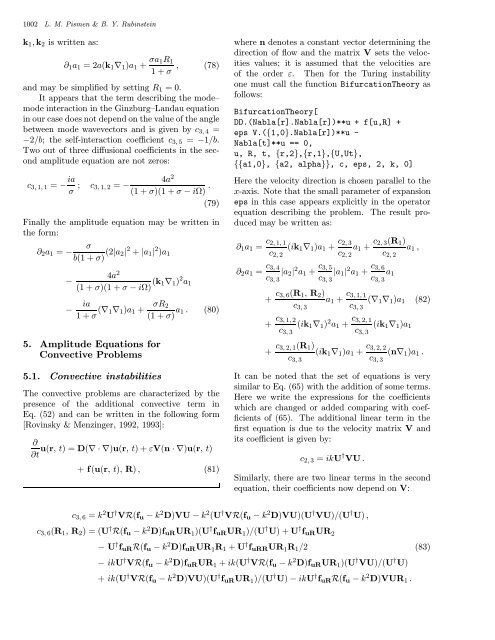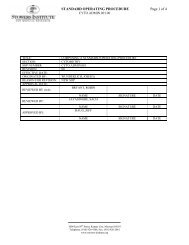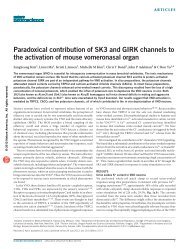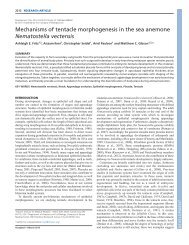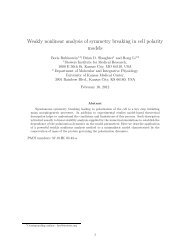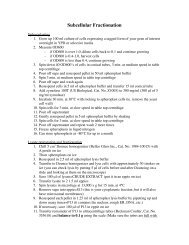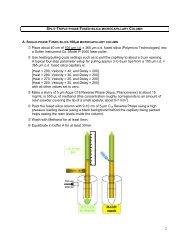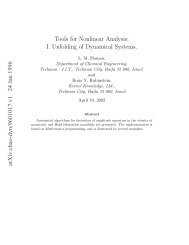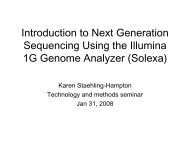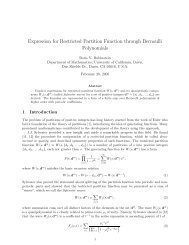Computer Tools for Bifurcation Analysis: General Approach with
Computer Tools for Bifurcation Analysis: General Approach with
Computer Tools for Bifurcation Analysis: General Approach with
You also want an ePaper? Increase the reach of your titles
YUMPU automatically turns print PDFs into web optimized ePapers that Google loves.
1002 L. M. Pismen & B. Y. Rubinstein<br />
k 1 , k 2 is written as:<br />
∂ 1 a 1 =2a(k 1 ∇ 1 )a 1 + σa 1R 1<br />
1+σ , (78)<br />
and may be simplified by setting R 1 =0.<br />
It appears that the term describing the mode–<br />
mode interaction in the Ginzburg–Landau equation<br />
in our case does not depend on the value of the angle<br />
between mode wavevectors and is given by c 3, 4 =<br />
−2/b; the self-interaction coefficient c 3, 5 = −1/b.<br />
Two out of three diffusional coefficients in the second<br />
amplitude equation are not zeros:<br />
c 3, 1, 1 = − ia σ ;<br />
c 4a 2<br />
3, 1, 2 = −<br />
(1 + σ)(1 + σ − iΩ) .<br />
(79)<br />
Finally the amplitude equation may be written in<br />
the <strong>for</strong>m:<br />
σ<br />
∂ 2 a 1 = −<br />
b(1 + σ) (2|a 2| 2 + |a 1 | 2 )a 1<br />
−<br />
−<br />
4a 2<br />
(1 + σ)(1 + σ − iΩ) (k 1∇ 1 ) 2 a 1<br />
ia<br />
1+σ (∇ 1∇ 1 )a 1 + σR 2<br />
(1 + σ) a 1 . (80)<br />
5. Amplitude Equations <strong>for</strong><br />
Convective Problems<br />
5.1. Convective instabilities<br />
The convective problems are characterized by the<br />
presence of the additional convective term in<br />
Eq. (52) and can be written in the following <strong>for</strong>m<br />
[Rovinsky & Menzinger, 1992, 1993]:<br />
∂<br />
u(r, t)=D(∇·∇)u(r,t)+εV(n·∇)u(r,t)<br />
∂t<br />
+f(u(r,t),R), (81)<br />
where n denotes a constant vector determining the<br />
direction of flow and the matrix V sets the velocities<br />
values; it is assumed that the velocities are<br />
of the order ε. Then <strong>for</strong> the Turing instability<br />
one must call the function <strong>Bifurcation</strong>Theory as<br />
follows:<br />
<strong>Bifurcation</strong>Theory[<br />
DD.(Nabla[r].Nabla[r])**u + f[u,R] +<br />
eps V.({1,0}.Nabla[r])**u -<br />
Nabla[t]**u == 0,<br />
u, R, t, {r,2},{r,1},{U,Ut},<br />
{{a1,0}, {a2, alpha}}, c, eps, 2, k, 0]<br />
Here the velocity direction is chosen parallel to the<br />
x-axis. Note that the small parameter of expansion<br />
eps in this case appears explicitly in the operator<br />
equation describing the problem. The result produced<br />
may be written as:<br />
∂ 1 a 1 = c 2, 1, 1<br />
c 2, 2<br />
(ik 1 ∇ 1 )a 1 + c 2, 3<br />
c 2, 2<br />
a 1 + c 2, 3(R 1 )<br />
c 2, 2<br />
a 1 ,<br />
∂ 2 a 1 = c 3, 4<br />
c 3, 3<br />
|a 2 | 2 a 1 + c 3, 5<br />
c 3, 3<br />
|a 1 | 2 a 1 + c 3, 6<br />
c 3, 3<br />
a 1<br />
+ c 3, 6(R 1 , R 2 )<br />
c 3, 3<br />
a 1 + c 3, 1, 1<br />
c 3, 3<br />
(∇ 1 ∇ 1 )a 1<br />
+ c 3, 1, 2<br />
c 3, 3<br />
(ik 1 ∇ 1 ) 2 a 1 + c 3, 2, 1<br />
c 3, 3<br />
(ik 1 ∇ 1 )a 1<br />
(82)<br />
+ c 3, 2, 1(R 1 )<br />
c 3, 3<br />
(ik 1 ∇ 1 )a 1 + c 3, 2, 2<br />
c 3, 3<br />
(n∇ 1 )a 1 .<br />
It can be noted that the set of equations is very<br />
similar to Eq. (65) <strong>with</strong> the addition of some terms.<br />
Here we write the expressions <strong>for</strong> the coefficients<br />
which are changed or added comparing <strong>with</strong> coefficients<br />
of (65). The additional linear term in the<br />
first equation is due to the velocity matrix V and<br />
its coefficient is given by:<br />
c 2, 3 = ikU † VU .<br />
Similarly, there are two linear terms in the second<br />
equation, their coefficients now depend on V:<br />
c 3, 6 = k 2 U † VR(f u − k 2 D)VU − k 2 (U † VR(f u − k 2 D)VU)(U † VU)/(U † U) ,<br />
c 3, 6 (R 1 , R 2 )=(U † R(f u −k 2 D)f uR UR 1 )(U † f uR UR 1 )/(U † U)+U † f uR UR 2<br />
− U † f uR R(f u − k 2 D)f uR UR 1 R 1 + U † f uRR UR 1 R 1 /2<br />
(83)<br />
− ikU † VR(f u − k 2 D)f uR UR 1 + ik(U † VR(f u − k 2 D)f uR UR 1 )(U † VU)/(U † U)<br />
+ ik(U † VR(f u − k 2 D)VU)(U † f uR UR 1 )/(U † U) − ikU † f uR R(f u − k 2 D)VUR 1 .


